In 2019, Seán LaBrie retired from his 24-year post at Calgary Police Department to embark on a new chapter as a full-time rancher at a 640ac property that he had purchased and began developing over the past 18 years.
Known locally as ‘Difficulty Ranch’, an unsurprising name given the challenges of raising cattle in Canada’s Alberta where conditions can be very dry in summer with heavy snowfall in winter, the 51-year-old, and his wife, Holly, stepped up to the plate.
The landowners were also undaunted by growing pressure from conservationist groups in the region urging farmers to adopt new methods to protect riparian zone vegetation along Dogpound Creek – a central province stream that meanders one and a quarter miles through the LaBrie holding.
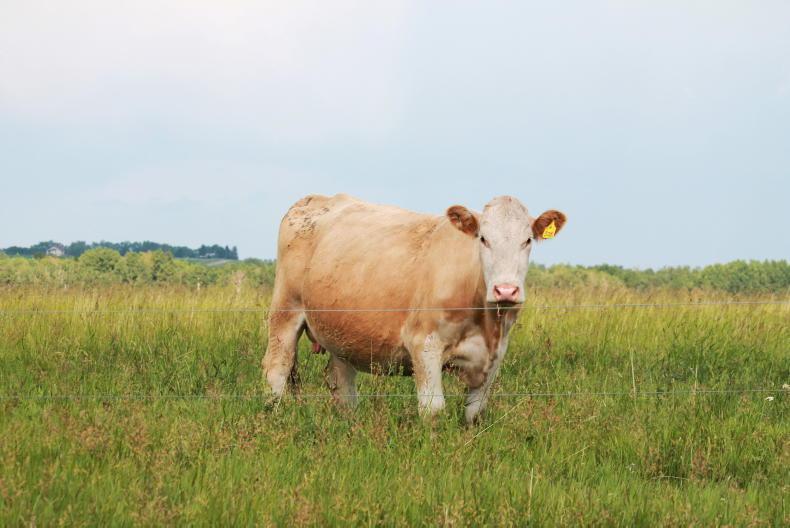
Stock grazing at Difficulty Ranch in west-central Alberta. \ Claire McCormack
Today, the diverse ranch runs a suckler herd of around 100 commercial Beefbooster cows, an Alberta-developed hybrid breed of beef cattle, while focusing on several environmentally regenerative agricultural practices and projects.
Speaking to the Irish Farmers Journal on a farm visit during the International Federation of Agricultural Journalists Congress to Canada, Seán explained how he is maximising rotational grazing in summer, while producing sufficient bale and swath grazing for the backend of the year.
“When we bought this place originally we pretty much leased everything out. I bought 16 cows so I had some skin in the game, but I didn’t know what I didn’t know, which was good because I had no barriers.
“I’m still not quite sure how a city kid managed to fool a bank into thinking we could make payments on this place, but we found a way through custom grazing.
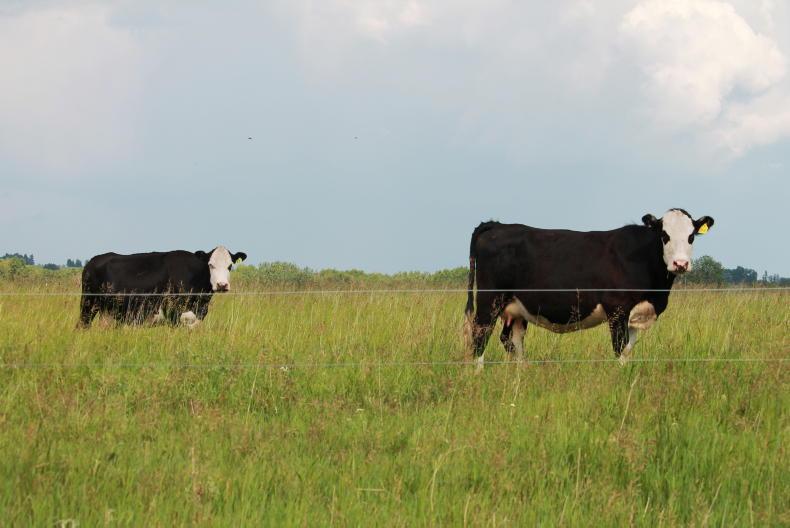
Seán La Brie’s suckler herd grazing in the summer sunshine. \ Claire McCormack.
“We went full-time four years ago. We wanted to take what had been a heavily overgrazed piece of land, manage it back, and turn it into a productive year-round rotational grazing operation.”
LaBrie’s farm is on one block broken into 34 paddocks, each 15ac to 25ac in size. It includes 100ac of swath grazing and five paddocks of riparian zones comprising a creek, oxbow wetlands and a benchmark area which cows cannot access and left for beavers to inhabit.
Environmental organisations
From the get-go, the father of two, to daughter Taryn (18) and son Dalton (16), partnered with environmental organisations Cows and Fish, the Alberta Conservation Association, and Alternative Land Use Services to get nature-based practices in place. The first action was to fence off the creek.
“We fenced the entire length of the creek. We don’t have cows going down there anymore. Our fence is a minimum of 100ft off the shoreline which keeps the manure and urine up on the pastures.
“We put in a solar watering well that came out of our south yard and we started making alleyways from the north yard down to the creek with each paddock being reached through a yard or an alley way, so we could always get water back to the corrals.
“We only graze the riparian areas every three years. In a dry year, like this one, I may need to go in there, but if I don’t have to, I’m not going to.

Difficulty Ranch is located in west-central Alberta, Canada. \ Claire McCormack
“At five years they will go in regardless because the areas will start to become overgrown.
“Biodiversity on the farm, especially in the riparian areas, is way more healthy. When the cows do get in, they really mow up the place.
“The native species will start to overtake the weedy species and the grass will keep the woody species at bay.
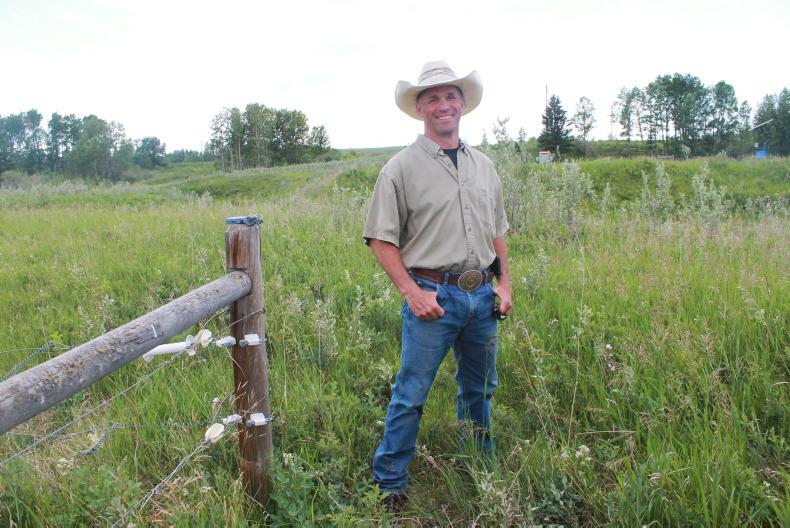
Rancher Seán LaBrie pictured at his riparian zone along the shoreline of Dogpound Creek. \ Claire McCormack
“We’ve lots of birch trees. Fir trees are coming back, which is great for carbon sequestration and bringing up moisture levels.
“This is now my daughter’s favourite moose pasture, but I do end up replacing a lot of fencing because they don’t jump over it.”
Wildlife
“We work hard with wildlife. I’ve got 100 deer coming through here but they’re eating my swath. Four to five deer eat what one cow eats, so I’m basically feeding an extra 25 cows on this place.
“I’m a firm believer in hunting but I manage it very closely, it isn’t a freebie to just come out here and hunt.”
The producer-driven Foothills Forage and Grazing Association also mentored Seán on soil and grassland management. He opted to use composite breed cows and bulls to increase his profitability and sustainability too.

Oil and gas extraction also take place at ‘Difficulty Ranch’. \ Claire McCormack
In the paddocks, the LaBries are doing swath grazing, grass, native pastures and extensive bale grazing. Swath grazing is a tool for locking in quality pasture much later into the winter for year-around grazing. The practice, widely adopted by livestock producers in western Canada, also reduces feed, labour and manure handling costs.
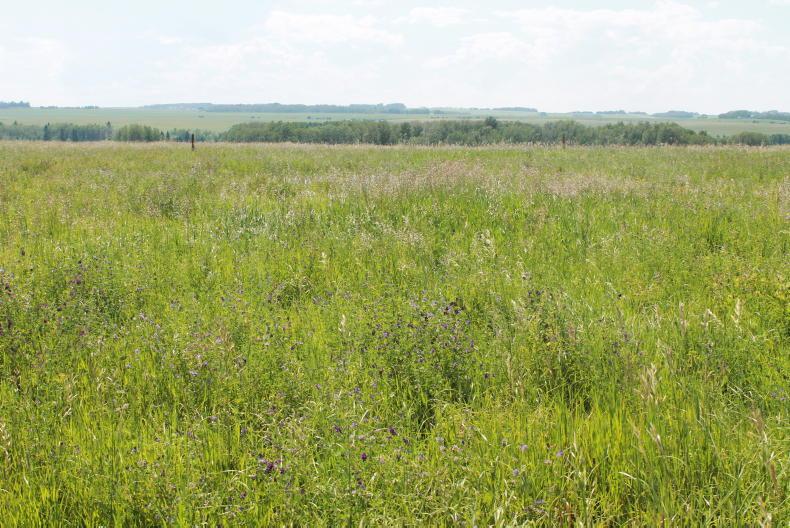
In the paddocks Seán LaBrie is doing swath grazing, grass, native pastures, and extensive bale grazing. \ Claire McCormack
For Seán, it involves annual cereals being seeded in early June and swathed (piled into rows) from late August to mid-September, when the crop reaches a dough stage and before the killing frosts. The swaths are left in the field for grazing during winter.
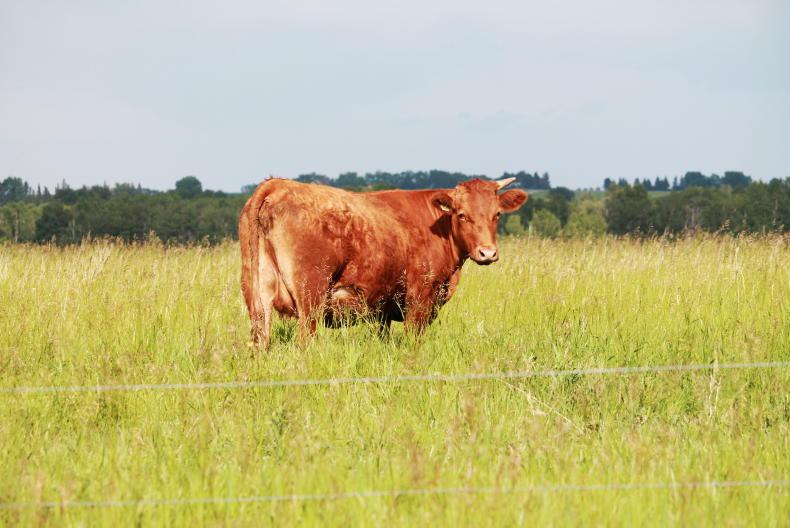
Seán LaBrie’s composite beef breed suckler herd out grazing on year-round rotational system. \ Claire McCormack
“I run 85 to 100 cow-calf pairs and 15 to 20 replacement heifers. I keep my own replacement heifers every year.
“We have the Beefbooster breed which started about 40 years ago in southern Alberta. A lot of people don’t like the composite, but I like the hybrid vigour of it.
“The calves are uniform, I don’t have one tall Simmental, one short Angus, one wild Corriente and one Belted Galloway or Hereford, but I do have colour in my herd, and some white. There is some Charolais too.
“We do year-round grazing, sometimes I get three rotations off my place. I try to avoid my swaths until November or December, I have 100ac of feed for 100 cows so that should last me 150 days. I don’t like to feed any more if I don’t have to, I buy a little bit of hay and straw but I don’t use silage.
“For our swath grazing, we use a high octane regiment of forage oats, Triticale, and Brassica rapeseed and forage peas.
“Generally, we are using 50% less than what the recommended seeding rate is as well as 50% less of the fertiliser rate and the forage is still coming up super heavy with the fields generally testing 13% to 15% protein with around three bales per acre.”

Birch trees and fir trees are increasing carbon sequestration and soil moisture levels at Difficulty Ranch. \ Claire McCormack
Calving
The LaBries calve in May-June, wean calves in January and sell them in January direct to a feedlot.
Asked about rate of gain in rotational grazing, Seán said: “I know that my calves are not gaining 2.5lbs (1.1kg)/day on silage, but they are gaining about 1.3-1.6lbs (0.5-0.7kg)/day on a fairly high-powered swath.
“This year, if I’m getting $3 (€2.04)/kg for a 550lbs (249kg) weight calf, we’ll be happy with that,” he said.
Seán doesn’t export any nutrients off-farm nor does he sell grain, hay or swaths. He also keeps minimal machinery and contracts in for custom seeding.
Asked about profitability, Seán said the section they first bought 18 years ago is “mortgage free” as of this year.
“Is all that on the back of cows? No, some of that is on the back of a policeman’s salary for 24 years, but I’m certainly going in the right direction – I’m not losing money. When I sell a calf, I know what it cost me to get that calf to market and I’m making money on that. I bill out at a $1.25 (0.85c)/day per cow-calf pair (including swaths, straw, labour and yardage). Swath grazing this year is going to cost me approximately $0.75/0.85c (0.51-0.58c)/day. I bill myself out at a measly $50 (€34.15)/hour, so all of that calculated together for a year, I’m still paying down the cow at a purchase price of $1,800 (€1,229) plus a calf.
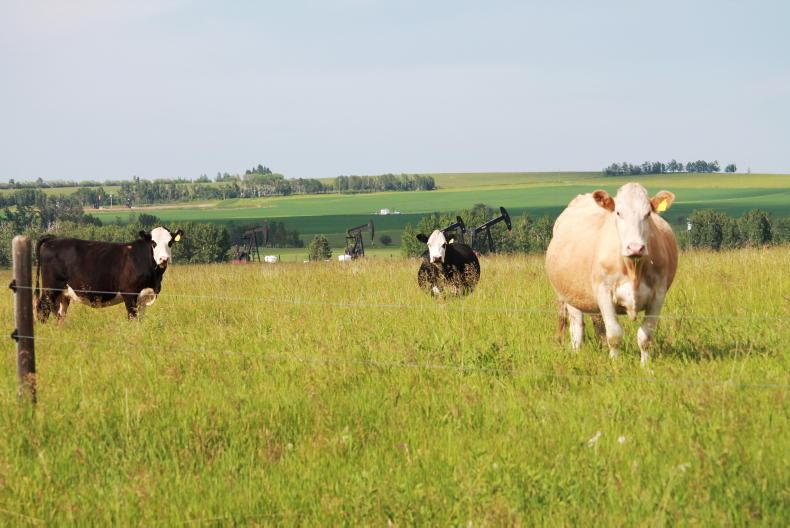
Stock grazing at Difficulty Ranch in west-central Alberta. \ Claire McCormack
“My strategy is that the calf has to pay to feed the cow through the winter and also pay me a wage, that’s profitability to me.
“The place is paying for itself now. It doesn’t require my off-farm income to pay for my ranching habit anymore.”
The LaBries also receive “a few thousand bucks” annually for oil and gas extraction leases on their holding; plus some small-scale supports from involvement in environmental schemes.
“My overall goal is to make sure this place can feed 100 animals every year with minimum reliance on bringing things in. I’m moving cows around, I’m moving seed around, and I’m seeing the benefits in species shift in the plants.
“Yes, it has been super difficult. We needed a lot of help. Grass management has been the biggest learning curve. But I’ve now reached a point where I consider myself more of a grass farmer than a cattle rancher and my passion is riparian.
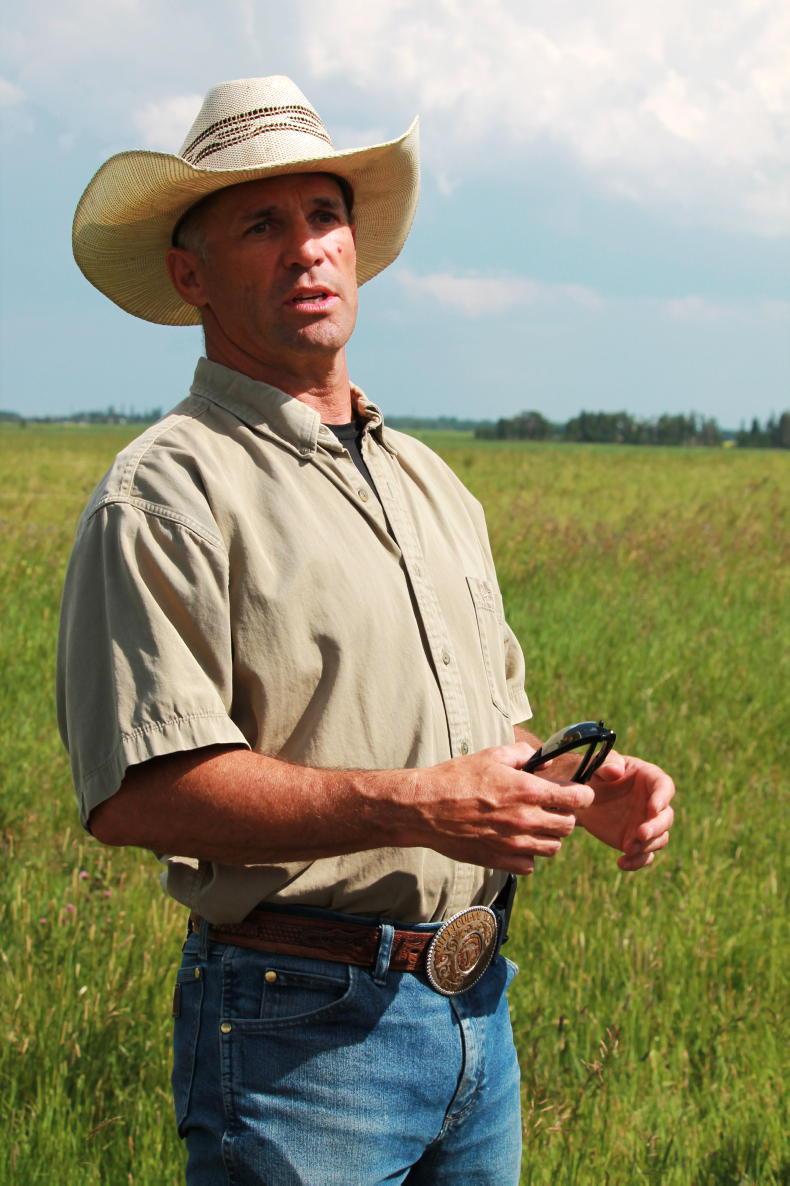
Cattle rancher Seán LaBrie of 'Difficulty Ranch'. \ Claire McCormack
“I’m also conscious that I burned a lot of fuel as a policeman. I raced motorcycles too, not knowing that it was environmentally damaging. Now, I want to give back.
“I get to come and do this every day and it’s fantastic – what a great way to retire ... or semi-retire,” he concluded.
In 2019, Seán LaBrie retired from his 24-year post at Calgary Police Department to embark on a new chapter as a full-time rancher at a 640ac property that he had purchased and began developing over the past 18 years.
Known locally as ‘Difficulty Ranch’, an unsurprising name given the challenges of raising cattle in Canada’s Alberta where conditions can be very dry in summer with heavy snowfall in winter, the 51-year-old, and his wife, Holly, stepped up to the plate.
The landowners were also undaunted by growing pressure from conservationist groups in the region urging farmers to adopt new methods to protect riparian zone vegetation along Dogpound Creek – a central province stream that meanders one and a quarter miles through the LaBrie holding.

Stock grazing at Difficulty Ranch in west-central Alberta. \ Claire McCormack
Today, the diverse ranch runs a suckler herd of around 100 commercial Beefbooster cows, an Alberta-developed hybrid breed of beef cattle, while focusing on several environmentally regenerative agricultural practices and projects.
Speaking to the Irish Farmers Journal on a farm visit during the International Federation of Agricultural Journalists Congress to Canada, Seán explained how he is maximising rotational grazing in summer, while producing sufficient bale and swath grazing for the backend of the year.
“When we bought this place originally we pretty much leased everything out. I bought 16 cows so I had some skin in the game, but I didn’t know what I didn’t know, which was good because I had no barriers.
“I’m still not quite sure how a city kid managed to fool a bank into thinking we could make payments on this place, but we found a way through custom grazing.

Seán La Brie’s suckler herd grazing in the summer sunshine. \ Claire McCormack.
“We went full-time four years ago. We wanted to take what had been a heavily overgrazed piece of land, manage it back, and turn it into a productive year-round rotational grazing operation.”
LaBrie’s farm is on one block broken into 34 paddocks, each 15ac to 25ac in size. It includes 100ac of swath grazing and five paddocks of riparian zones comprising a creek, oxbow wetlands and a benchmark area which cows cannot access and left for beavers to inhabit.
Environmental organisations
From the get-go, the father of two, to daughter Taryn (18) and son Dalton (16), partnered with environmental organisations Cows and Fish, the Alberta Conservation Association, and Alternative Land Use Services to get nature-based practices in place. The first action was to fence off the creek.
“We fenced the entire length of the creek. We don’t have cows going down there anymore. Our fence is a minimum of 100ft off the shoreline which keeps the manure and urine up on the pastures.
“We put in a solar watering well that came out of our south yard and we started making alleyways from the north yard down to the creek with each paddock being reached through a yard or an alley way, so we could always get water back to the corrals.
“We only graze the riparian areas every three years. In a dry year, like this one, I may need to go in there, but if I don’t have to, I’m not going to.

Difficulty Ranch is located in west-central Alberta, Canada. \ Claire McCormack
“At five years they will go in regardless because the areas will start to become overgrown.
“Biodiversity on the farm, especially in the riparian areas, is way more healthy. When the cows do get in, they really mow up the place.
“The native species will start to overtake the weedy species and the grass will keep the woody species at bay.

Rancher Seán LaBrie pictured at his riparian zone along the shoreline of Dogpound Creek. \ Claire McCormack
“We’ve lots of birch trees. Fir trees are coming back, which is great for carbon sequestration and bringing up moisture levels.
“This is now my daughter’s favourite moose pasture, but I do end up replacing a lot of fencing because they don’t jump over it.”
Wildlife
“We work hard with wildlife. I’ve got 100 deer coming through here but they’re eating my swath. Four to five deer eat what one cow eats, so I’m basically feeding an extra 25 cows on this place.
“I’m a firm believer in hunting but I manage it very closely, it isn’t a freebie to just come out here and hunt.”
The producer-driven Foothills Forage and Grazing Association also mentored Seán on soil and grassland management. He opted to use composite breed cows and bulls to increase his profitability and sustainability too.

Oil and gas extraction also take place at ‘Difficulty Ranch’. \ Claire McCormack
In the paddocks, the LaBries are doing swath grazing, grass, native pastures and extensive bale grazing. Swath grazing is a tool for locking in quality pasture much later into the winter for year-around grazing. The practice, widely adopted by livestock producers in western Canada, also reduces feed, labour and manure handling costs.

In the paddocks Seán LaBrie is doing swath grazing, grass, native pastures, and extensive bale grazing. \ Claire McCormack
For Seán, it involves annual cereals being seeded in early June and swathed (piled into rows) from late August to mid-September, when the crop reaches a dough stage and before the killing frosts. The swaths are left in the field for grazing during winter.

Seán LaBrie’s composite beef breed suckler herd out grazing on year-round rotational system. \ Claire McCormack
“I run 85 to 100 cow-calf pairs and 15 to 20 replacement heifers. I keep my own replacement heifers every year.
“We have the Beefbooster breed which started about 40 years ago in southern Alberta. A lot of people don’t like the composite, but I like the hybrid vigour of it.
“The calves are uniform, I don’t have one tall Simmental, one short Angus, one wild Corriente and one Belted Galloway or Hereford, but I do have colour in my herd, and some white. There is some Charolais too.
“We do year-round grazing, sometimes I get three rotations off my place. I try to avoid my swaths until November or December, I have 100ac of feed for 100 cows so that should last me 150 days. I don’t like to feed any more if I don’t have to, I buy a little bit of hay and straw but I don’t use silage.
“For our swath grazing, we use a high octane regiment of forage oats, Triticale, and Brassica rapeseed and forage peas.
“Generally, we are using 50% less than what the recommended seeding rate is as well as 50% less of the fertiliser rate and the forage is still coming up super heavy with the fields generally testing 13% to 15% protein with around three bales per acre.”

Birch trees and fir trees are increasing carbon sequestration and soil moisture levels at Difficulty Ranch. \ Claire McCormack
Calving
The LaBries calve in May-June, wean calves in January and sell them in January direct to a feedlot.
Asked about rate of gain in rotational grazing, Seán said: “I know that my calves are not gaining 2.5lbs (1.1kg)/day on silage, but they are gaining about 1.3-1.6lbs (0.5-0.7kg)/day on a fairly high-powered swath.
“This year, if I’m getting $3 (€2.04)/kg for a 550lbs (249kg) weight calf, we’ll be happy with that,” he said.
Seán doesn’t export any nutrients off-farm nor does he sell grain, hay or swaths. He also keeps minimal machinery and contracts in for custom seeding.
Asked about profitability, Seán said the section they first bought 18 years ago is “mortgage free” as of this year.
“Is all that on the back of cows? No, some of that is on the back of a policeman’s salary for 24 years, but I’m certainly going in the right direction – I’m not losing money. When I sell a calf, I know what it cost me to get that calf to market and I’m making money on that. I bill out at a $1.25 (0.85c)/day per cow-calf pair (including swaths, straw, labour and yardage). Swath grazing this year is going to cost me approximately $0.75/0.85c (0.51-0.58c)/day. I bill myself out at a measly $50 (€34.15)/hour, so all of that calculated together for a year, I’m still paying down the cow at a purchase price of $1,800 (€1,229) plus a calf.

Stock grazing at Difficulty Ranch in west-central Alberta. \ Claire McCormack
“My strategy is that the calf has to pay to feed the cow through the winter and also pay me a wage, that’s profitability to me.
“The place is paying for itself now. It doesn’t require my off-farm income to pay for my ranching habit anymore.”
The LaBries also receive “a few thousand bucks” annually for oil and gas extraction leases on their holding; plus some small-scale supports from involvement in environmental schemes.
“My overall goal is to make sure this place can feed 100 animals every year with minimum reliance on bringing things in. I’m moving cows around, I’m moving seed around, and I’m seeing the benefits in species shift in the plants.
“Yes, it has been super difficult. We needed a lot of help. Grass management has been the biggest learning curve. But I’ve now reached a point where I consider myself more of a grass farmer than a cattle rancher and my passion is riparian.

Cattle rancher Seán LaBrie of 'Difficulty Ranch'. \ Claire McCormack
“I’m also conscious that I burned a lot of fuel as a policeman. I raced motorcycles too, not knowing that it was environmentally damaging. Now, I want to give back.
“I get to come and do this every day and it’s fantastic – what a great way to retire ... or semi-retire,” he concluded.
















 This is a subscriber-only article
This is a subscriber-only article










SHARING OPTIONS: